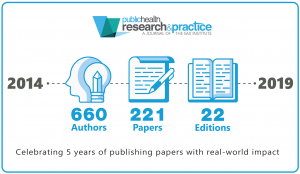PHRP journal celebrates five years of outstanding health research
The Sax Institute’s journal Public Health Research & Practice (PHRP) is turning five – and what a half decade it’s been, publishing peer-reviewed papers that have a real-world impact.
In five years, with the publication of 22 issues and 221 papers, the journal has transformed from The NSW Public Health Bulletin to an internationally recognised journal.
Editor-in-Chief Professor Don Nutbeam says the anniversary is an opportunity to reflect on the evolution of the journal and its many past contributors at the NSW Ministry of Health, where it was originally published for nearly 25 years before passing to the Sax Institute in 2014.
“From its very pragmatic origins, PHRP has since grown into a journal that is Australian in character, but international in its outlook,” says Professor Nutbeam. “And we’re proud to be distinctive in this ambition – bringing together science and practice in public health, in a form that is both accessible and useable by researchers, public health practitioners and policy makers.”
To date, PHRP has published articles from more than 650 authors, attracted 3,200 subscribers, and continues to grow internationally, with 40% of readers now outside Australia. The vision has always been to unearth innovative, high-quality papers that inform public health policy and practice, from a startling 2016 review of the health risks of passive exposure to electronic cigarette vapour, to a perspective piece by world-renowned public health expert Professor Trisha Greenhalgh on how to improve the chances of success for technology projects in healthcare.
Themed editions of the journal have drawn together leading experts and the latest research to highlight, explain and offer solutions to some of the greatest public health challenges of our time, such as managing the effects of climate change on health and reducing childhood obesity.
Some of the journal’s papers have also sparked public debate. One example is this paper in the September 2019 issue, which found that lobbying on behalf of food, alcohol and gambling companies by ex-politicians and political staffers was posing a serious threat to public health. A front-page piece in The Australian newspaper and extensive media coverage set off discussion about the need for tighter regulations around ‘cooling-off periods’ between government employment and lobbying roles.
Also receiving widespread interest was a paper featured in the July 2019 issue (created in partnership with Cancer Institute NSW and Cancer Council Australia), which revealed the emerging issues in cancer screening in Australia. The authors highlighted that lung cancer screening was an opportunity to prevent thousands of lung cancer deaths, especially among former smokers. Two weeks after the issue was published, the federal Minister for Health announced an inquiry into the feasibility of a national lung cancer screening program.
These kinds of high-impact results are a win for authors, but also for the peer reviewers and editors who have spent countless hours sifting through the latest research to make PHRP what it is today. As Professor Nick Talley, Editor-in-Chief of the Medical Journal of Australia points out, it’s important for Australia to nurture a range of top-line journals that readers can turn to for the best in health research.
“PHRP is making a real contribution in this space,” he says. “The world of health publishing is going through great change as it becomes increasingly online, and while this presents challenges for all of us, it also opens up new opportunities for showcasing high-quality Australian research that can help inform the future of public health policy.”
So, with five years of high-impact research and a dedicated readership under its belt, what could the next five years hold for PHRP? The journal’s founding Editor, Anne Merkel, says the journal is poised to scale even greater heights. “With Editor Nyssa Skilton taking over the reins with gusto, and Editor-in-Chief Don Nutbeam providing guidance, I think PHRP continues to get better with every issue,” she says. “Success breeds success, meaning more top-notch authors and peer reviewers are giving their valuable time and support to the journal. This in turn leads to more readers and viewers – a virtuous circle that I hope continues for many years to come.”
Read the diverse range of research published by PHRP, join them on twitter, or sign up for the quarterly newsletter here.


